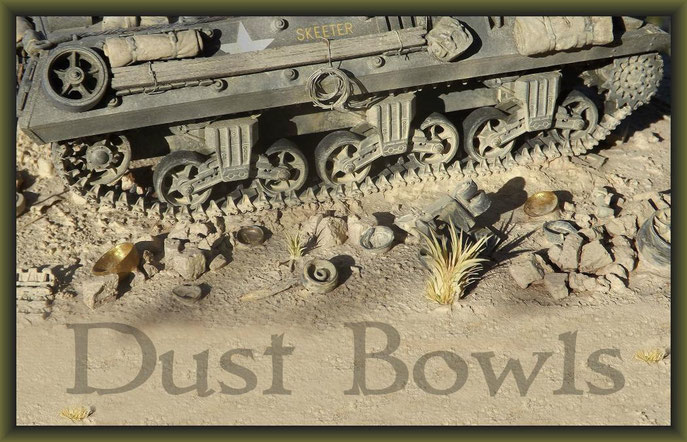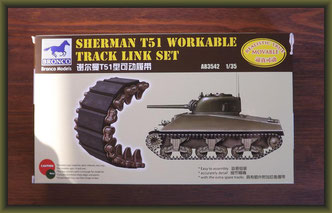Tunisia, March 1943
The successful failure.
Although they were ultimatly victorios in destroying the German Army in North Africa, the losses incurred to the fledgling U.S. forces were also not without significance.
Rushed into action, their new organisation, training, tactics and weapons were proved to be initialy no match for the experience of their enemy. Of these mistakes, the one of the centralised Tank Destroyer force was the most flawed. Originally concieved to counter the en masse Panzer threat of '39-'40, it was found to be wanting in the face of the new German tactics of '43.
The enemy's use of smaller and more flexible units, sometimes lying in ambush positions, made them very slippery fish to catch. The Panzers were now not so obliging as to turn up at the right time and place to be knocked out. In face of this , the T.D. motto of "Seek, Strike and Destroy" became more and more redundant.
In this scenario and against procedure, field commanders were forced to send them into battle in a piece-meal and offensive fashion. With their thin armour and open top - lethargic turning turrets set against the seasoned German Panzers and PAK's … the results were often disastrous.
Endless squabbles at higher levels, over the type of weapons/vehicles to be best suited for the job, did nothing to help, let alone solve the problem.
Among the different vehicles used as T.D.'s, I've chosen the M10 GMC for this particular "dust off".
My AFV Club model is not as good as the new Tamiya kit but not so bad as the Academy offering.
The latter is too high and narrow, but the former is also a bit of a "failure" in some areas:
No exhaust deflector, crew hatches not rounded off and the turret is a touch too wide. The last problem I've attempted to "deform out of scrutiny" with crew and baggage.
Another minor glitch is the rear bulkhead firewall. The ammo recesses do not match up with the ammo tubes and the floor is too high. As this area will not be seen, I've just chopped and reset them roughly. Note how the corner boxes line up with the top of the sponsons. This point is worth considering not only for an open version but as regards standing figures. The upper hull was a bit far back for my liking, so I've moved it forward ca. 1.8mm. If you fancy doing the same on your kit - be careful because the upper hull will "rise". Dry fit and mark the area's to reduce on the lower hull accordingly.
No ammo with the kit, well that's not a bad thing as AFV Club's offering is too close to 76mm.
On the other side of the globe I found that V.P.'s 76mm looked a lot more like 3-inch ammo which has a distinct "bottle-neck" to them.

With a little filing I managed to jam five of them in the rear turret.
Having "bashed" some Miniart figures into position I took on the Bronco tracks, or should that be: they took me on?
To achive the workable tracks advertised, then one has to place the minutest coat of cement on all of the depicted red points. If one dribbles about, even in the slightest, then one ends up with … two steel rulers. So, if you're planning to have a swing at this track link set, then my advice is to give it miss and save money for "eats" 😏
Right then, let's go Retro.
No indirect sight on this early version, but I have built in (copying an original photo) some sort of Gyro/target acquisition (?) mechanism near the commanders station. Rounded differential/final drive housing and horn. Flat bar grouser brackets and .50 small ammo box.
My main concern though, was scratchbuilding the 3“ Guns early counterweights. These were only to be seen around the Kasserine and El Guettar battles (Feb- March), with the 601, 776 and 899 T.D. Battalions. After which they were refitted with the more familiar intermediate wedge shaped types. These lead (sometimes steel) blocks appear to have been secured by a steel plate fixed to the top face with flat bar welded to it and to rear of the turret. Additional weld seams run around the base of the block and handgrips fastend to the remains of the old grouser rack are visable along the top.
Adding to my headache, was the fact that photo's of these counterweights are very rare. I could only find five pictures of the things and three of them were from a distance. Even though the kits turret was slightly off and in the absence of a technical drawing, I decided to painfully go for line of site copying. This technique involves the comparison to all photo's available, holding the parts over the picture at a distance so it is of the same size. Then by constant comparison, correcting mass and adjusting the angles. T'was a bit like modelling a circus clown … no small feat!
The markings were also a bit of a puzzle to make out. Some vehicles had red stripes along the sponsons as a depth gauge during amphibious landings, others had traces of unit/registration numbers. In some units it was common to camouflage the vehicles olive drab using Tunisian mud. At this time it was discovered that the white stars could be misinterpreted, at a distance, for the enemy's "Balkenkreuze". To make them more apparent, they were ringed with a white (sometimes yellow) outer circle. In light of all this I've decided to keep the markings to a minimum and present it as belonging to ? unit.
The name SKEETER, by the way, is Oklahoman slang for Mosquito (moSKEETER). Subtle recognition of another dust bowl from the pen of the late great John Steinbeck.
Arab pots 'n' pans on the base mimic the vehicles open topped and dust collecting nature.
As always, it's the men on the front line who have to correct the failings of their high command.
By gradually morphing it into a direct and indirect artillery piece, the M10 became a highly mobile fire suppression platform. It also evolved into an exellent infantry support weapon, it's
3'' Gun being more than capable of taking out a myrad of "hold-up's" and vehicles.When luck allowed or the devil drove, it sometimes reverted to it's original purpose as a tank killer.
In it's new roles, it not only saved many allied lives but released the Tank Divisions and Battalions to deal with the German Panzer threat.
The Tank Destroyer concept was a failure that was never repeated. A bowl of ideas that turned to dust on the hard proving grounds of the plains, valleys and passes of Tunisia.
The future successes of the M10 Gun Motor Carriage, in the last years of WWII, lay in not what it was designed to do ... but in what it was capable of.
M10 GMC (early)
Building Stages:
Completed: 20.11.'18
 The
Gun Bucket
The
Gun Bucket





































































